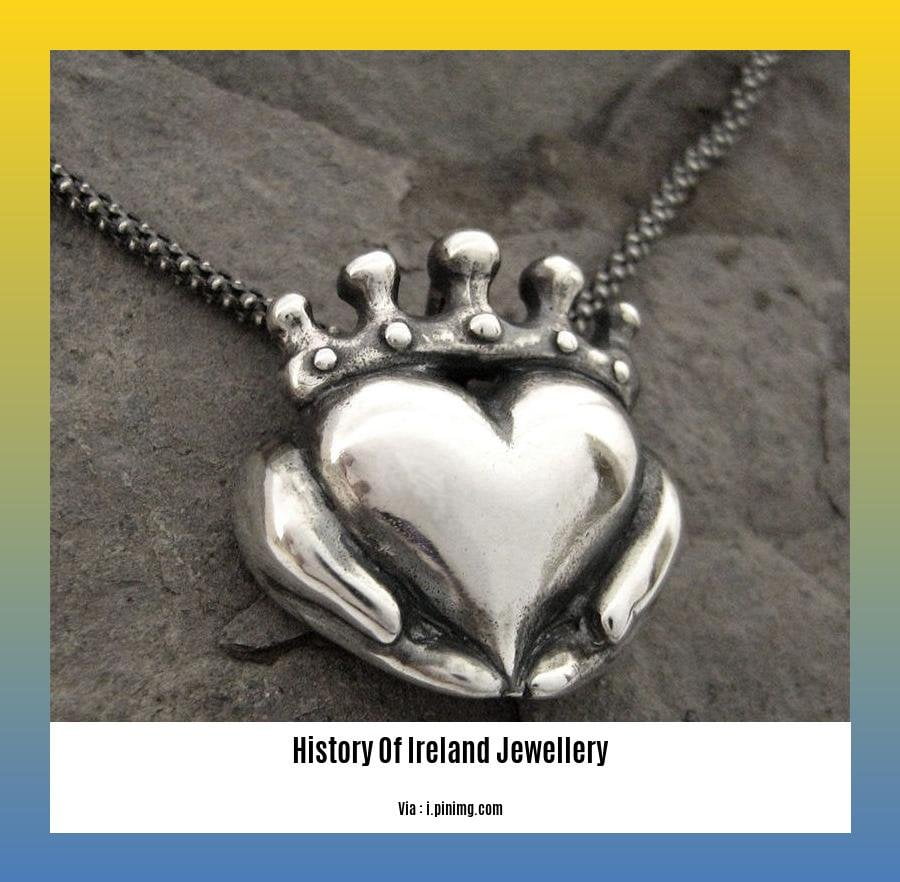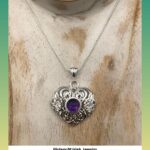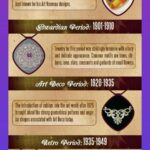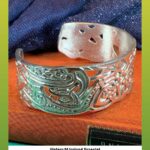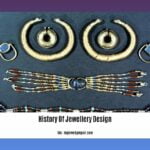Embarking on a Journey Through Time: Unraveling the History of Irish Jewellery, we delve into the depths of Celtic heritage, where intricate designs and masterful craftsmanship intertwine to tell the story of a nation’s cultural identity. From ancient treasures to contemporary masterpieces, Irish jewelry captivates with its unique blend of tradition and innovation.
Key Takeaways:
-
The colors of the Irish Tricolour flag represent Gaelic tradition (green) and Protestant supporters of William of Orange (Orange).
-
The Circle of Life symbol, inspired by ancient Celtic carvings, stands for sacredness and eternity.
-
St. Patrick is credited with transforming Ireland to Christianity in the 5th century.
-
Ireland’s history is influenced by Viking raids that began in 795 AD.
-
Round Towers are significant structures that served as places of refuge and defense for Christians.
-
Irish rings often carry symbols representing Irish heritage, like the Claddagh ring for love, loyalty, and friendship.
-
Celtic Jewelry Designs showcase Ireland’s rich heritage with Trinity Knot and Celtic Cross symbols.
-
Solvar History of Ireland jewelry includes symbols of important events and figures, like the Celtic cross and St. Patrick.
History of Ireland Jewellery
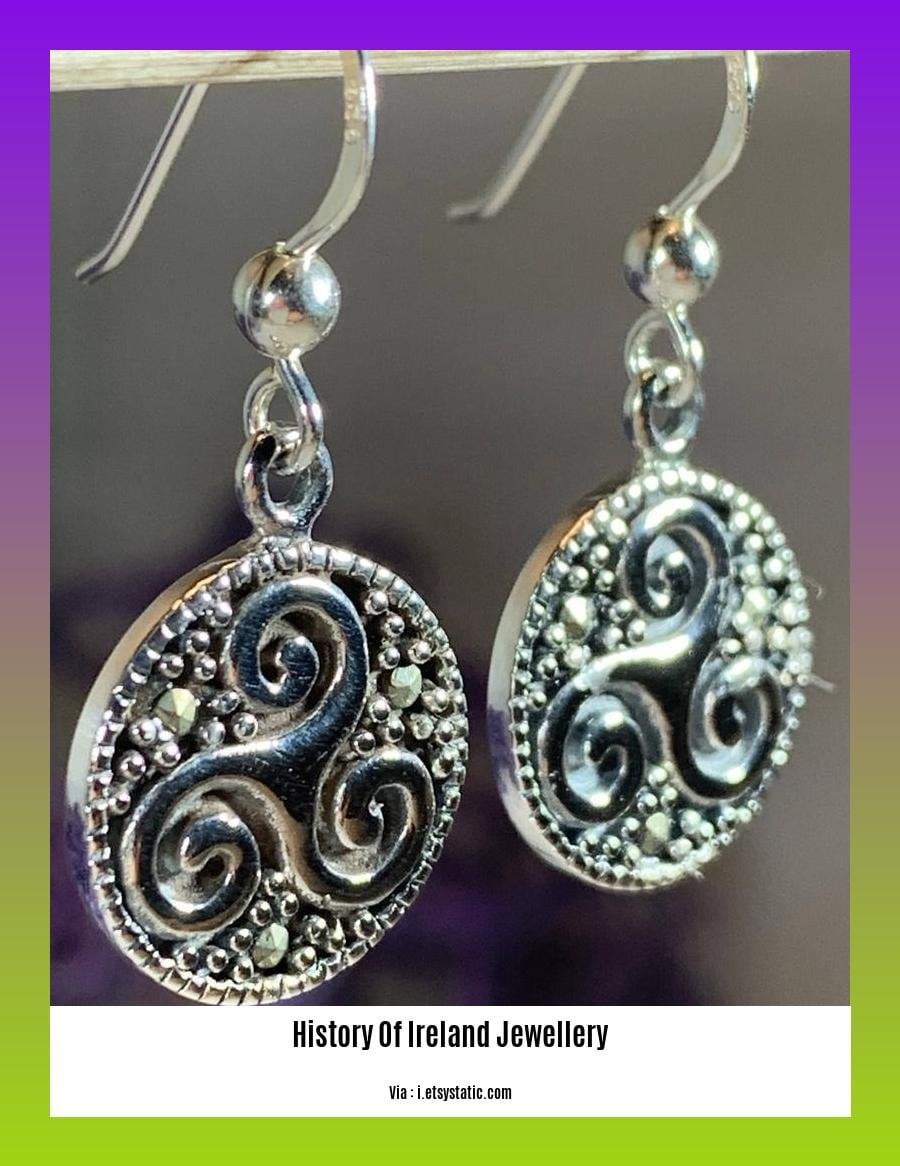
Unveiling the rich tapestry of Ireland’s heritage through the lens of its exquisite jewelry, we embark on a journey that echoes with tales of ancient traditions, cultural pride, and craftsmanship that has stood the test of time. Ireland’s jewelry is more than just adornment; it is an embodiment of the nation’s spirit, a testament to its artistry, and a poignant reminder of its fascinating past.
The Celtic Legacy: A Tapestry of Symbols
The Celts, with their intricate knotwork and iconic symbols, left an indelible mark on Irish jewelry. The Trinity Knot, an emblem of the eternal bond between past, present, and future, became a recurring motif, along with the Celtic Cross, a fusion of Christian and pagan symbolism. These intricate designs whispered stories of ancient beliefs and legends, each twist and turn imbued with meaning.
The Vikings: A Fusion of Art and Ferocity
The arrival of the Vikings in the 8th century brought a fresh infusion of artistic influence. Their love of sleek, geometric patterns and bold forms blended seamlessly with the intricate Celtic designs, creating a hybrid style that was both striking and unique. Viking jewelry often featured intricate filigree work, intricate animal motifs, and mesmerizing gemstone accents.
The Georgian Era: Elegance and Refinement
The Georgian era, spanning the 18th and early 19th centuries, ushered in a period of elegance and refinement. Jewelry designs took on a more delicate and feminine air, with intricate scrollwork, floral motifs, and sparkling gemstones. Brooches, necklaces, and earrings became popular accessories, embodying the grace and sophistication of the era.
The Revival of Celtic Traditions: A Return to Roots
The 19th century witnessed a resurgence of interest in Ireland’s Celtic heritage. Jewelry designers began to draw inspiration from the ancient symbols and motifs, incorporating them into contemporary pieces that celebrated Irish identity. This revival was not just a fashion statement; it was a cultural movement that sought to reconnect with the nation’s rich past.
Contemporary Irish Jewelry: A Fusion of Past and Present
Today, Irish jewelry continues to evolve, blending traditional motifs with modern design aesthetics. Contemporary jewelry designers are pushing the boundaries of creativity, using innovative techniques and materials to create pieces that are both visually stunning and deeply rooted in Irish heritage.
Irish jewelry is more than just a fashion statement; it is a tangible link to a rich and vibrant past, a celebration of cultural pride, and an art form that continues to captivate and inspire. As we delve into the intricacies of its history, we discover a world where craftsmanship, symbolism, and timeless beauty converge, creating a legacy that will endure for generations to come.
-
Dive into the captivating history of Hindustani music and trace its evolution from ancient origins to its vibrant present-day form. history of Hindustani music
-
Adorned with mesmerizing patterns and symbols, our Ireland bracelets narrate the rich historical journey of the Emerald Isle, inviting you to embrace its ancient Celtic legacy. history of Ireland bracelet
-
Our Ireland rings are more than mere adornments; they symbolize the indomitable spirit of the Irish people. Embark on an enchanting journey through history as you marvel at these exquisitely crafted rings. history of Ireland ring
Medieval Masterpieces: Uncovering the exquisite craftsmanship and artistic influences of medieval Irish jewelry, showcasing pieces adorned with precious metals, enamelwork, and gemstones.
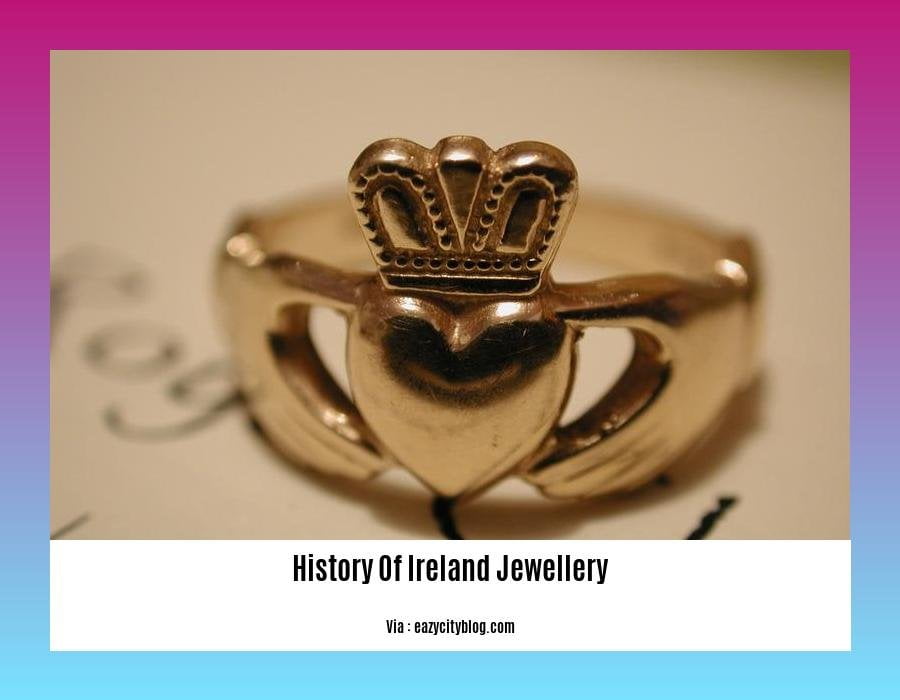
The Middle Ages witnessed a flourishing of artistic expression in Ireland, with jewelry emerging as a captivating testament to the period’s exquisite craftsmanship and artistic influences. Skilled artisans wove intricate designs using precious metals, enamelwork, and gemstones, creating masterpieces that transcended mere adornment to become symbols of wealth, status, and cultural identity.
Precious Metals: A Foundation of Opulence
Gold and silver, nature’s gifts of radiance, served as the foundational materials for medieval Irish jewelry. Gold, with its inherent nobility, was reserved for the elite, while silver’s versatility adorned both the wealthy and the common folk. These metals were meticulously fashioned into intricate forms, showcasing the artisan’s mastery in shaping and manipulating the material.
Enamelwork: A Splash of Color and Symbolism
Enameling, a decorative technique involving the fusion of colored glass onto metal, added a vibrant palette to medieval Irish jewelry. Artisans employed champlevé and cloisonné techniques, creating intricate designs and symbolic motifs that brought life to the metallic surfaces. These colorful accents, often featuring geometric patterns or figural representations, transformed jewelry into miniature works of art.
Gemstones: Nature’s Precious Embellishments
Precious and semi-precious gemstones, with their captivating hues and symbolic associations, played a prominent role in medieval Irish jewelry. Emeralds, with their verdant brilliance, symbolized abundance and prosperity, while sapphires, with their deep blue hues, represented wisdom and celestial connection. Rubies, with their fiery red glow, embodied passion and vitality, while pearls, with their gentle iridescence, spoke of purity and innocence.
Key Takeaways:
-
Medieval Irish jewelry showcased exquisite craftsmanship, utilizing precious metals, enamelwork, and gemstones.
-
Gold and silver formed the foundation of medieval Irish jewelry, with gold reserved for the elite and silver adorning a broader audience.
-
Enameling techniques, such as champlevé and cloisonné, brought vibrant colors and symbolic motifs to jewelry designs.
-
Precious and semi-precious gemstones, including emeralds, sapphires, rubies, and pearls, added a touch of opulence and symbolism to jewelry pieces.
Relevant Sources:
-
Cleveland Museum of Art: Medieval Masterpieces
-
Invaluable: Medieval Art: Characteristics and Influences
Georgian and Victorian Eras: Examining the evolution of Irish jewelry during these periods, marked by the introduction of new techniques and styles, including the Claddagh ring and the incorporation of Celtic motifs.
The Georgian and Victorian eras marked a significant chapter in the history of Irish jewelry, characterized by the fusion of traditional Celtic influences with new techniques and styles. During this period, Ireland experienced profound social, political, and cultural changes that left an indelible mark on its jewelry-making traditions.
A Journey Through Time
The Georgian era, from 1714 to 1830, witnessed the rise of a prosperous middle class in Ireland. This newfound affluence fueled a growing demand for exquisite jewelry, leading to the establishment of numerous workshops and guilds specializing in the craft. Georgian jewelers drew inspiration from the Rococo style prevalent in France, incorporating intricate scrollwork, floral motifs, and sparkling gemstones into their designs.
The Victorian era, which spanned from 1837 to 1901, marked a period of cultural revival in Ireland. There was a renewed interest in the country’s Celtic heritage, leading to the incorporation of ancient symbols and motifs into jewelry design. The Claddagh ring, with its iconic heart, hands, and crown, became a symbol of love and fidelity, while the Trinity Knot, representing the Father, Son, and Holy Spirit, gained popularity as a symbol of faith.
Key Takeaways:
-
The Georgian era brought elegance and refinement to Irish jewelry, with delicate scrollwork, floral motifs, and sparkling gemstones becoming popular.
-
The Victorian era saw a revival of interest in Ireland’s Celtic heritage, leading to the incorporation of ancient symbols and motifs into contemporary pieces.
-
The Claddagh ring, representing love and fidelity, and the Trinity Knot, symbolizing the Holy Trinity, emerged as iconic designs during this period.
-
Irish jewelry during the Georgian and Victorian eras showcased a blend of traditional Celtic influences and new techniques, reflecting the country’s evolving cultural identity.
Relevant Sources:
[1] “Irish Jewelry History.” National Museum of Ireland, www.museum.ie/en-IE/Museums/Decorative-Arts-History/Exhibitions/Past-Exhibitions/Irish-Jewellery-History.
[2] “Georgian and Victorian Jewelry.” The Irish Jewelry Company, www.theirishjewelrycompany.com/georgian-and-victorian-jewelry.
Contemporary Revival: Exploring the resurgence of Irish jewelry in the 20th and 21st centuries, highlighting the work of renowned designers and the blending of traditional techniques with modern aesthetics.
The 20th and 21st centuries witnessed a remarkable resurgence of Irish jewelry, characterized by a blend of traditional techniques with modern aesthetics and a surge in renowned designers. This period marked a significant shift in the landscape of Irish jewelry, pushing it forward into the realm of contemporary and cutting-edge designs while respecting its rich heritage.
Renewed Inspiration From Ancient Roots
The Celtic Revival movement of the 19th century ignited renewed interest in Ireland’s ancient heritage, including its art and jewelry. This revival laid the foundation for contemporary Irish jewelry designers to draw inspiration from traditional Celtic symbols, intricate knotwork, and timeless motifs, reimagining them in modern contexts.
Bridging Past and Present: Renowned Irish Jewelry Designers
A cohort of talented Irish jewelry designers emerged during this period, propelling Irish jewelry into the spotlight. They combined traditional craftsmanship with innovative designs, bridging the gap between past and present. These pioneers included:
- Angela O’Rafferty: Known for her intricate Celtic-inspired pieces and use of traditional materials such as gold and silver.
- Liam Ó Maonlaí: His designs showcased a blend of traditional techniques and contemporary styles, with a focus on geometric shapes and bold forms.
- Catherine Fulvio: Her jewelry was characterized by its vibrant colors and use of enamel, combining traditional Irish motifs with modern aesthetics.
These designers, among many others, played a pivotal role in shaping the contemporary face of Irish jewelry. Their work showcased the harmonious coexistence of tradition and modernity, paving the way for the current generation of Irish jewelers.
Global Recognition and International Renown
Contemporary Irish jewelry gained international recognition, with Irish designers showcasing their creations at prestigious exhibitions and galleries worldwide. This global exposure catapulted Irish jewelry to the forefront of the international fashion and design scene, garnering accolades and accolades for its unique blend of tradition and innovation.
Key Takeaways:
- The 20th and 21st centuries witnessed the resurgence of Irish jewelry, characterized by a blend of traditional techniques with modern aesthetics.
- Renowned Irish jewelry designers, like Angela O’Rafferty, Liam Ó Maonlaí, and Catherine Fulvio, spearheaded this revival, fusing traditional craftsmanship with innovative designs.
- Contemporary Irish jewelry achieved global recognition, gracing international exhibitions and galleries, establishing its place in the global fashion and design landscape.
Sources:
- Irish Jewelry History and Design
- Irish Jewelry: A History of Innovation
FAQ
Q1: What distinguishes Irish jewelry from other types of jewelry?
A1: Irish jewelry is renowned for its intricate Celtic designs, which often incorporate symbols that hold cultural significance, such as the Trinity Knot, the Celtic Cross, and the Claddagh ring. These designs are inspired by Ireland’s rich history and heritage.
Q2: Can you explain the significance of the Trinity Knot in Irish jewelry?
A2: The Trinity Knot, also known as the Triquetra, is a prominent symbol used in Celtic art and jewelry. It represents the Holy Trinity in Christianity, embodying the Father, Son, and Holy Spirit. It’s often interpreted as a symbol of eternal life and everlasting love.
Q3: What is the history behind the Claddagh ring?
A3: The Claddagh ring is a traditional Irish ring that symbolizes love, loyalty, and friendship. It originated in the fishing village of Claddagh, Galway, and features two hands holding a heart, with a crown on top. The hands represent friendship, the heart represents love, and the crown represents loyalty.
Q4: How did the Celtic Revival movement influence Irish jewelry design?
A4: The Celtic Revival movement, which took place in the late 19th and early 20th centuries, sparked a renewed interest in Irish culture and heritage. This led to a revival of traditional Celtic designs in jewelry, incorporating symbols and motifs from ancient Irish art and mythology.
Q5: What are some of the most popular types of Irish jewelry?
A5: Some of the most popular types of Irish jewelry include Celtic knot rings, Claddagh rings, Trinity Knot pendants, Tara brooches, and Celtic cross necklaces. These pieces are often made from precious metals like gold and silver, and may incorporate gemstones or enamel for added beauty.
- Unveiling the Enigma: Mansoureh Khojasteh Bagherzadeh’s Public Appearances & Private Life in Iran - July 18, 2025
- Unveiling the Mystery: Mansoureh Khojasteh Bagherzadeh’s Husband: A Rare Glimpse into a Private Life - July 18, 2025
- Unveiling Masoud Khamenei’s Mother: Power, Influence, and Iran’s Future - July 18, 2025
